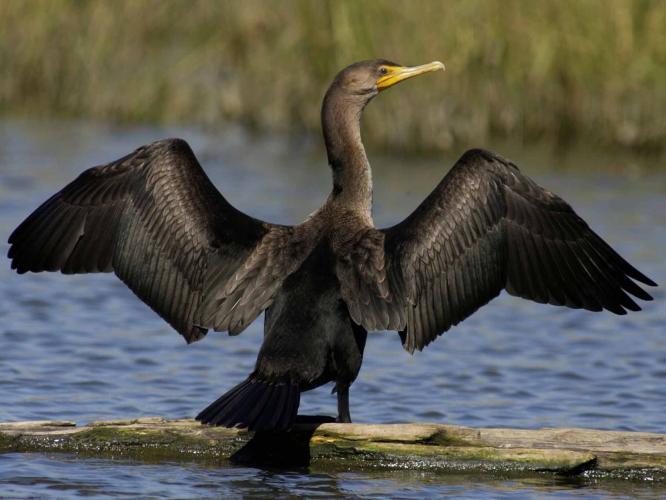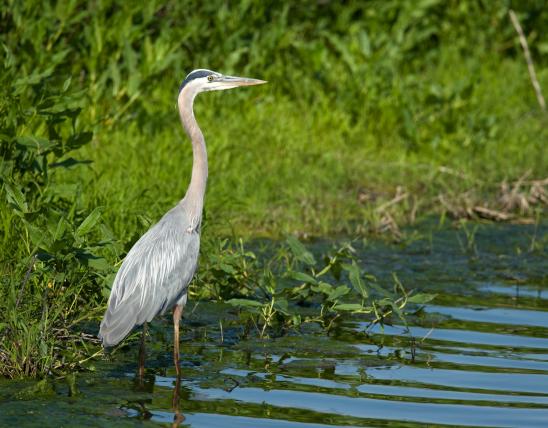
Double-crested cormorants are dark, ducklike water birds with long necks, hooked bills, legs set far back on the body, and a habit of hanging their wings out to dry in the sun. Adults are black with a yellowish-orange skin pouch below a long, hook-tipped bill; the skin patch extends around the eye. Immatures are brownish with a whitish breast. Frequently observed in large numbers sitting upright on snags over water, sometimes with wings outstretched. The “double crest” is a pair of tufts behind the eyes that this species acquires only during breeding season.
Similar species:
- Cormorants can be confused with anhingas when soaring. In flight, the anhinga may be distinguished by its longer, fanned-out, squared-off tail. At rest, anhingas have a “snakier” neck than cormorants do. Anhingas have a pointed bill that is not hook-tipped. The anhinga is a casual transient and summer visitor that formerly bred in Pemiscot and Dunklin counties. Irregularly seen from late April through mid-September.
- The neotropic cormorant (P. brasilianus) is a transient and summer visitor in Missouri (rare in the western part of the state and accidental in the eastern part). It is smaller and slenderer than the double-crested but has a longer tail and a proportionately smaller bill. Its dark orange skin patch is edged with white, and the skin patch does not extend around the eye. In breeding season, adults have a white patch of plumes on the side of the head and small white feathers scattered over the neck.
Length: 32 inches (tip of bill to tip of tail).

Statewide.
Habitat and Conservation
Common migrant on lakes and rivers. Currently breeds some years along the Mississippi River.
Cormorants frequently dive completely underwater. They often come to the surface with only the neck and head sticking out of the water. When swimming at the water's surface, their bodies are usually very low in the water.
Historically, breeding colonies were located in the Mississippi Lowlands until 1956. Cormorant numbers dropped during the years of DDT but have risen in the Midwest, at least in part, due to habitat changes and introduced species. Numbers have risen remarkably in the Great Lakes, where fishermen claim they compete for game fish, and where their roosting colonies create enough guano to kill island trees.
Food
Cormorants dive underwater for fish, surfacing on occasion but remaining submerged except for the neck and head. To decrease buoyancy and facilitate underwater swimming, cormorants’ feathers have few of the oils that repel water, so they become soaked as the bird swims. This is why cormorants typically stand with wings outstretched: They are allowing their feathers to dry.
Status
Common transient; accidental summer (breeding) resident; rare summer visitor; rare winter resident.
Life Cycle
Nests are constructed on the ground, on rocks, or in treetops by both partners and are built of sticks and lined with grass. Nests are 1–3 feet wide and are typically built near those of other pairs in breeding colonies. Clutches comprise 1–7 eggs, which hatch in 25–28 days. The young leave the nest about 3 or 4 weeks later. There are 1 or 2 broods annually.
Human Connections
Humans have historically viewed cormorants as competitors for game fish and, until the early 1900s, shot and persecuted them, causing populations to decline. In about the 1950s, pesticides further reduced their populations. Their numbers have rebounded, but many still view them as pests.
Many species of cormorants occur worldwide, and humans have used them in many ways: symbolically and in folklore, as a source for feathers for clothing, and even as a hood ornament (the Packard "swan"). Perhaps most remarkable is the ancient use of cormorants as fishers, which continues today as a centuries-old cultural tradition in parts of east Asia.
Ecosystem Connections
Cormorant numbers in Lake Erie are linked to the presence of the invasive zebra mussel, a filter feeder that clarifies water, which helps cormorants hunt fish more successfully. Also, less plankton means fewer small fish, reduced fish numbers overall, and increasing competition between people and cormorants.










Where to See Species
About 350 species of birds are likely to be seen in Missouri, though nearly 400 have been recorded within our borders. Most people know a bird when they see one — it has feathers, wings, and a bill. Birds are warm-blooded, and most species can fly. Many migrate hundreds or thousands of miles. Birds lay hard-shelled eggs (often in a nest), and the parents care for the young. Many communicate with songs and calls.




























